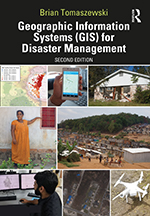
|
Chapter 6: Geographic Information Systems and Disaster Planning and Preparedness |
This is the companion website for Chapter 6: Geographic Information Systems and Disaster Planning and Preparedness from the book Geographic Information Systems (GIS) for Disaster Management (second edition). This page contains links to any technical video walk throughs contained in the chapter, slides for the chapter, chapter test questions, and other additional materials.
Chapter Abstract
This chapter introduces the concept of geographic information systems (GIS) for disaster preparedness and disaster planning. Geographic information capacity is first presented as a prelude to outlining essential disaster management map layers that must be in place before a disaster strikes. An international disaster preparedness case study from the GRID 3 project is presented to demonstrate efforts at creating geographic information capacity in developing countries. Organizational perspectives are then made to emphasize the importance of collaboration and sharing of data, people, tools, and other resources when disaster occurs via examples such as data sharing agreements and memorandums of understanding (MOUs). Common GIS tasks for disaster planning and preparation activities are discussed such as evacuation route and zone planning, scenario modeling to answer what -if questions along with a 3D GIS serious game case study, and spatial statistics and Hot Spot Mapping. Use of GIS for public outreach and citizen participation in disaster planning and preparation activities and use of GIS by non-GIS professionals via topics such as counter mapping and critical cartography, refugee camp mapping with students, and non-profit groups are also discussed. The chapter concludes with a technical exercise on hot spot analysis and visualization of conflict events.
Chapter Objectives: Upon chapter completion, readers should be able to:
- identify essential geographic information systems (GIS) datasets that should be acquired, developed, and curated during disaster-planning activities;
- understand planning and preparedness organizational perspectives in terms of memorandums of understanding and cooperation agreements on the use of GIS datasets and other resources for disaster management;
- discern how GIS can be used as a support tool for common disaster planning and preparation activities, such as evacuation route and zone planning;
- understand the importance of scenario modeling for training purposes in the use of GIS to help answer what-if questions for disaster planning;
- understand select spatial statistics methods for planning;
- understand how GIS can be used for public outreach and citizen participation during disaster planning and preparation activities;
- understand the nature of GIS and disaster management planning and preparation on an international scale;
- understand the use of GIS by non-GIS professionals for disaster planning and preparation.
Follow these links to access Chapter 6: Geographic Information Systems and Disaster Planning and Preparedness materials:
- Chapter 6 Slides (.pptx, 16.8 mb)
- Exercise 6-1: Hot Spot Analysis and Visualization of Conflict Events video walkthrough
- Chapter 6 Test Bank (.docx, 20 kb) | Chapter 6 Test Bank (.pdf, 141 kb)
For information on this chapter, purchase the book from Routledge Press »